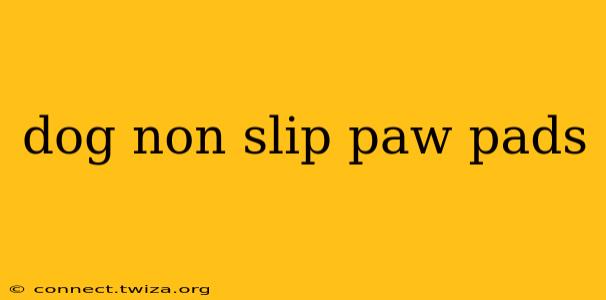Dogs, with their boundless energy and love of exploring, often encounter slippery surfaces that can lead to falls and injuries. This is where dog non-slip paw pads come in. These ingenious little devices offer a crucial layer of protection and traction, enhancing your canine companion's safety and comfort, both indoors and out. This guide delves into the world of dog non-slip paw pads, answering your most pressing questions and helping you choose the perfect fit for your furry friend.
What are Dog Non-Slip Paw Pads?
Dog non-slip paw pads are protective coverings for your dog's paws, designed to provide extra grip on slick surfaces like hardwood floors, tile, or even icy pavements. They come in various materials, styles, and designs, catering to different breeds, sizes, and activity levels. These pads typically feature a non-slip bottom, often made of rubber or silicone, and a comfortable top layer that protects your dog's paws from abrasions and cold.
Why are Non-Slip Paw Pads Important for My Dog?
Preventing slips and falls is paramount to your dog's safety and well-being. Slippery surfaces can lead to:
- Injuries: Falls can cause sprains, fractures, or even more severe injuries, especially in smaller or older dogs.
- Loss of Confidence: Repeated slips can make your dog hesitant to move around confidently, particularly on certain surfaces.
- Discomfort: Cold, hard surfaces can be uncomfortable for your dog's paws, especially in colder climates. Paw pads provide a layer of insulation and protection.
What Types of Non-Slip Paw Pads are Available?
The market offers a variety of dog non-slip paw pads, each with unique features:
- Socks: These are the most common type, typically made from a blend of fabrics with a rubber or silicone bottom. They offer good coverage and protection.
- Booties: These are more substantial than socks, often offering better protection against harsh weather conditions and more robust traction. They're ideal for outdoor use.
- Individual Pads: These are separate pads applied to each paw, offering targeted protection and are often easier to put on than socks or booties.
The material also varies. Look for breathable, comfortable materials that are easy to clean and durable.
How Do I Choose the Right Size and Fit?
Proper sizing is crucial for both comfort and effectiveness. Measure your dog's paws carefully, ensuring you choose pads that fit snugly but aren't too tight. Refer to the manufacturer's size chart for the best fit. Loose pads can easily slip off, defeating their purpose.
How Do I Put Non-Slip Paw Pads on My Dog?
Most dogs will require some acclimatization to wearing paw pads. Start by introducing them gradually, letting your dog sniff and explore them before attempting to put them on. Positive reinforcement with treats and praise can make the process much smoother. Once your dog is comfortable, gently place each pad onto its respective paw.
Are Non-Slip Paw Pads Suitable for All Dogs?
While generally safe, it's crucial to monitor your dog after applying the pads. Some dogs may experience irritation or discomfort. If you notice any redness, swelling, or excessive licking, remove the pads immediately and consult your veterinarian. Puppies and dogs with existing paw conditions should be particularly monitored.
How Do I Clean Dog Non-Slip Paw Pads?
Cleaning instructions vary depending on the material. Most can be hand-washed with mild soap and water and air-dried. Always check the manufacturer's instructions for specific cleaning recommendations.
Can Non-Slip Paw Pads Help with Older Dogs or Dogs with Arthritis?
Yes, non-slip paw pads can be particularly beneficial for older dogs or dogs with arthritis. The added traction can help prevent falls, improving their mobility and confidence, reducing the risk of further injury.
What are the Best Non-Slip Paw Pads for My Dog? (This section requires more specific information, like breed size, activity level, and climate to give tailored recommendations. Generic recommendations can be provided focusing on different types of pads).
This guide provides a comprehensive overview of dog non-slip paw pads, but individual needs vary. Always prioritize your dog's comfort and safety when selecting and using these products. Consult your veterinarian if you have concerns about your dog's mobility or paw health.
